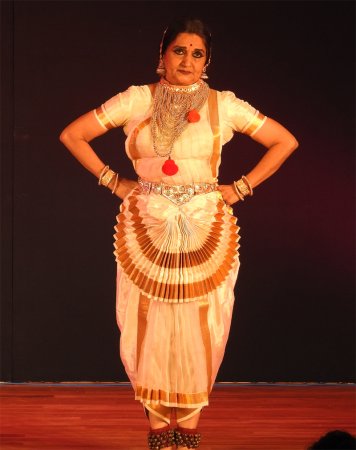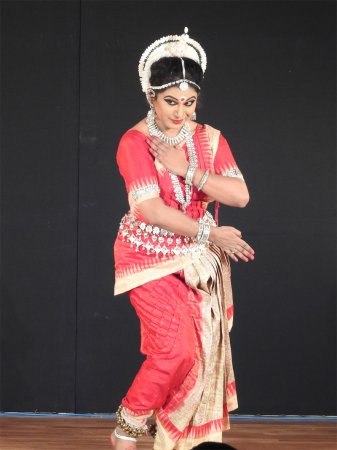
|   |

|   |
Dances of the Ashta Nayika created magic on stage - Simran Khurana e-mail: simran.glen@gmail.com March 6, 2020 There were eight of them. Different heroines. Different shades of love. What better way to bring Valentine's Day than to present the Ashta Nayika! The Ashta Nayika is an interesting subject in the Natya Shastra. You get to see the Nayika (heroine) in various phases of love: the woman dressed up, the woman deceived, the woman in control, the woman in pangs of separation, the woman distressed after a fight, the woman enraged, and so on. I have often heard the argument that the Ashta Nayikas are not relevant in today's day and age. We live in an emancipated world, where polygamy has no place. Our women are not to be treated as doormats or football. Women have a voice, and the right to exercise their choice. But on the flipside, though times have changed, and the context of relationships has evolved (most societies practice monogamy, unlike polygamy in the olden days) women still undergo the same range of emotions as their predecessors did a thousand years ago. For instance, while it is true that a woman would hardly tolerate infidelity and deception in the modern age, she can't help but undergo the same phases of emotional upheaval such as hurt, anger, devastation, and rage as does the Khandita Nayika of Bharata Muni's Natya Shastra. On the chilly evening of February 8, 2020, all roads led to a small studio in a lesser known part of Mumbai. The NCPA Mumbai Dance Season in association with Sanskrita Foundation and Natanam Studio of Fine Arts, organized a beautiful program titled 'Namanee -Ashta Nayika.' Under the able guidance of Shubhada Varadkar, a leading exponent of Odissi dance, the Sanskrita Foundation had organized a star-studded evening of classical dances to be presented by Darshana Jhaveri, Dr. Uma Rele, Ranjana Phadke, Nandini Krishna, Shila Mehta, Mandakini Trivedi, Shubhada Varadkar and Prateesha Suresh. These names were enough to entice classical dance lovers from around Mumbai to brave the evening traffic and make it on time to watch the unifying concept of Ashta Nayika. Though the dance styles differed, the common theme that was underlying the entire presentation made everything look seamless and well-constructed.  Ashta Nayika The evening began with Darshana Jhaveri's Manipuri dance on Manini Radha. The octogenarian, bedecked in the finery of Manipuri dance costume including the Kumil, had a little difficulty getting on to the stage. But once she began, she transformed into a 16-year-old Radha in love with Krishna. Her graceful gliding moves, body swaying to the beat of the song took you back to a world of charming gopis around Lord Krishna. The round of applause that reverberated in the studio was testimony to Darshana Jhaveri's prowess and the popularity of the Manipuri dance form. Bharatanatyam dancer Nandini Krishna played the Swadhina Patika nayika, one who has strong emotional connect with her lover. He is hooked by her beauty and intelligence. And that is exactly what Nandini Krishna presented. Her confident gait, the slow turn of her head, and haughty glance revealed who called the shots. Effectively presented, the versatile dancer set the stage for the rest of the evening.  Mandakini Trivedi Though I have had very little exposure to Mohiniattam, Mandakini Trivedi's Mohiniattam left me speechless. Depicting the Kalanhantarita nayika, Mandakini Trivedi presented a little scene where a jilted heroine's husband's affliction for other beautiful women leaves her distressed and quarrelsome. However, she also finds the pangs of separation unbearable, and hopes for a reunion with her dearest. Trivedi, a seasoned dancer, not just played the roles of man and woman exceedingly well, she also portrayed a man putting on the guise of a woman to fool his beloved. For a woman to act as a man who in turn is acting as a woman was a feat by itself. And she pulled it off with aplomb! Not only was she convincing in her role, she also presented a comical side of the situation when the man is clueless on how to dress up as a woman. In her detailed portrayal, you could see her manly swagger, as he clumsily tries to wear a woman's blouse and skirt, cover his head with the dupatta, and adorn himself with bangles and jewels to cover his manly body. Her dance showed a range of emotions from hurt, betrayal, distress, fear and eventually love. She left everyone gaping in wonderment. Kathak is a dance form closest to my heart. Shila Mehta presented the Swadhinapatika nayika with a beautiful Surdas poetry. The dancer brought a blend of shringar (romance) and aadhyatma (spiritual) with her evocative performance. Prateesha Suresh followed with a Sattriya dance performance. It was only in the year 2000 that Sattriya dance from the state of Assam was recognized as a classical dance by Sangeet Natak Akademi. The Sattriya dance has its roots in the Natya Shastra. Prateesha Suresh took on the role of the Swadhina Bhartruka nayika, the heroine where her lover is devoted to her. In this nritya, Prateesha enacted a playful interaction between Lord Krishna and his first wife Rukmini. You can see the devotion, love, and trust that Rukmini has for her husband in this act. The dancer moves slowly, gracefully, beating her feet to the tala that is played in the song. Her graceful postures and delicate moves were a delight. The Swadhina Bhartruka nayika has many shades. And so it seemed from the variety of presentations we saw that night. While it is important that the Swadhina Bhartruka heroine expresses her love, confidence, and self-worth through her dance, she could do this under different circumstances. In the next presentation, we saw a new dimension of the Swadhina Bhartruka nayika. Here, Lord Krishna is woefully smitten by Radha. The two have a covert exchange of glances and gestures in a hidden language, so that the other gopis don't understand what they are communicating with each other. It was a treat to watch Dr. Uma Rele enact Radha and Krishna so expressively. Her vast expanse of knowledge and experience was distilled to perfection here. Subtlety is a rare art, and expressions with subtle gestures are a feat only masters can achieve. The expressions were so nuanced that you could easily miss a flutter of an eyelash or a slightly raised eyebrow with a lingering smile if you didn't look carefully enough. But that's the beauty of Indian dance forms. You have to immerse yourself into the show to get the pure joy of the presentation. I secretly wished that we could request a repeat performance from the dancers as it did not seem like the audience was in any hurry to leave. The next performance was by Ranjana Phadke, a renowned Kathak exponent. She presented a ghazal, taking a somber note for the evening with the Virahot Kanthita nayika, an anguished lover, who is suffering the pangs of separation. She is tormented by memories of love and hopes to reunite with her lover. The notes of the ghazal touched you deep within. Ranjana Phadke poured her heart into this touching depiction of a broken heart.  Shubhada Varadkar The last performance of the evening was by Shubhada Varadkar, the versatile Odissi dancer, orator, cultural activist, reformer, cancer survivor, teacher and mother, all rolled into one. As an integral part of the NCPA Mumbai Dance Season team and the lead organizer for many of the dance programs held around the city during the month, Shubhada Varadkar is a woman who wears many hats with panache. When Shubhada Varadkar came on to the stage as the Swadhinapatika Radha, dressing up for the eternal union with her lover Lord Krishna, the audience was mesmerized. She was the epitome of grace, elegance, and finesse, so balanced and measured was her every move. Transformed into a divine goddess, Shubhada Varadkar showed the world that nothing is impossible if you really want to achieve something. Her closing performance was a perfect end to a beautiful evening of dances. Remarkably, while each dancer went up on stage to perform, the other dancers sat among the audience to watch the performance. They were not busy backstage rehearsing or mingling with their fans. They were not caught up absorbed in their own thoughts. Instead, they were focused and intently watching all others perform. It was a beautiful display of humility and respect accorded to other dancers. What we saw was not just a sparkling ensemble of Ashta Nayika presentations, but we also saw a solid team of seasoned artists, each being an effective role model for the younger generation. Every dancer dived deep into her performance and shone brilliantly. But more importantly, every dancer knew that her journey was incomplete and there was more to learn. It was a sight to behold!  Simran Khurana is a Kathak dancer, and researcher, with over two decades of writing experience, having worked with national and international publications. An avid music and dance lover, Simran aims to bring about a synergy between her profession and passion. |